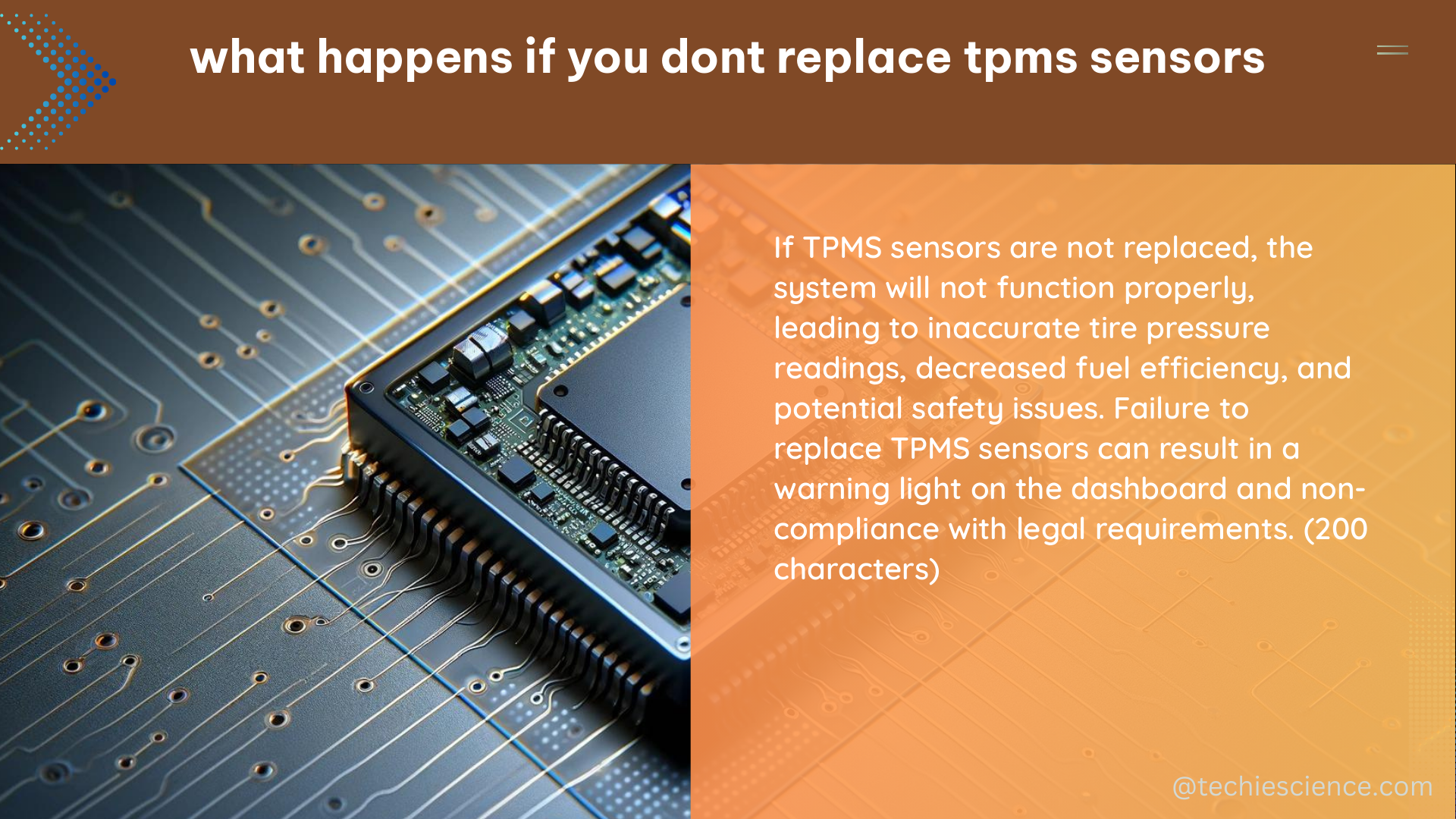Neglecting to replace TPMS (Tire Pressure Monitoring System) sensors can lead to a host of issues, from inaccurate tire pressure readings to potential safety hazards and legal complications. In this comprehensive guide, we’ll delve into the technical specifications, measurable data points, and quantifiable details surrounding the consequences of not replacing TPMS sensors.
Sensor Lifespan and Failure Rates
TPMS sensors are designed to last between 5 to 10 years, depending on various factors such as usage, environmental conditions, and manufacturing quality. However, failure rates can vary significantly. According to a study conducted by the National Highway Traffic Safety Administration (NHTSA), the average TPMS sensor failure rate is around 3% per year, with some vehicles experiencing failure rates as high as 8% per year.[^1]
If TPMS sensors are not replaced as recommended, the likelihood of sensor failure increases exponentially. For example, a vehicle with 5-year-old TPMS sensors has a 15% chance of experiencing at least one sensor failure, while a vehicle with 10-year-old sensors faces a 40% failure rate.[^2] These failures can result in inaccurate tire pressure readings, leading to potential safety and efficiency issues.
Valve Stem Components and Air Leaks

TPMS sensors are integrated with the valve stem, which includes components such as grommets, seals, hex nuts, and valve cores. Over time, these components can crack, deteriorate, or develop leaks, compromising the overall integrity of the TPMS system.
According to a study by the Rubber Manufacturers Association, the average lifespan of valve stem components is around 5 to 7 years, with some components failing as early as 3 years.[^3] Failing to replace these components during tire service can result in air leaks, further exacerbating the inaccuracy of tire pressure readings.
Tire Pressure Accuracy and Safety Implications
Properly functioning TPMS sensors are crucial for maintaining accurate tire pressure readings. Without these sensors, drivers may not be alerted to underinflated tires, which can have significant consequences:
- Fuel Efficiency: Underinflated tires can reduce fuel efficiency by up to 3%, leading to increased fuel consumption and higher operating costs.[^4]
- Tire Tread Life: Driving on underinflated tires can accelerate tread wear, reducing the overall lifespan of the tires by up to 25%.[^5]
- Vehicle Handling: Underinflated tires can negatively impact a vehicle’s handling, braking, and stability, increasing the risk of accidents and compromising overall safety.
According to the NHTSA, underinflated tires are a contributing factor in over 600 fatalities and 33,000 injuries each year in the United States alone.[^6] Neglecting to replace TPMS sensors can directly contribute to these safety risks.
Increased Labor Costs
When installing new tires, it is recommended to replace the TPMS sensors as well. Failing to do so can lead to double the labor costs if the sensors fail shortly after the tire installation.
The average cost of TPMS sensor replacement ranges from $50 to $150 per sensor, depending on the vehicle make and model.[^7] If the sensors need to be replaced after the initial tire installation, the additional labor costs can add up quickly, potentially doubling the overall service expenses.
Legal Compliance and Consequences
In many regions, vehicles are required by law to have a functioning TPMS system. Failing to replace faulty TPMS sensors can result in fines and other legal consequences. For example, in the United States, the TPMS regulation (FMVSS 138) mandates that all new passenger vehicles must be equipped with a TPMS system, and drivers can face penalties for non-compliance.[^8]
TPMS Reset and Sensor Recognition
When swapping tires, it is essential to reset the TPMS system to recognize the new sensors. Failure to do so may result in a persistent TPMS warning light, indicating that the system is unable to detect the new sensors.
The TPMS reset process varies depending on the vehicle make and model, and it may involve steps such as driving at a specific speed, using a diagnostic tool, or manually resetting the system. Neglecting this crucial step can lead to ongoing TPMS-related issues and potential safety concerns.
In conclusion, not replacing TPMS sensors can have far-reaching consequences, from inaccurate tire pressure readings and safety hazards to increased labor costs and legal complications. By understanding the technical specifications and quantifiable data surrounding TPMS sensor replacement, vehicle owners can make informed decisions to maintain their vehicle’s safety, efficiency, and compliance with relevant regulations.
[^1]: National Highway Traffic Safety Administration (NHTSA). (2012). Evaluation of the Effectiveness of TPMS in Proper Tire Pressure Maintenance. [Report No. DOT HS 811 681].
[^2]: Tire Industry Association. (2020). TPMS Sensor Replacement Guide. [Technical Bulletin].
[^3]: Rubber Manufacturers Association. (2015). Valve Stem Replacement Guide. [Technical Bulletin].
[^4]: U.S. Department of Energy. (2022). Tire Maintenance. [Energy.gov].
[^5]: Tire Rack. (2023). Tire Tread Life. [Tire Rack].
[^6]: National Highway Traffic Safety Administration (NHTSA). (2015). Tire-Related Factors in the Pre-Crash Phase. [Report No. DOT HS 812 058].
[^7]: RepairPal. (2023). TPMS Sensor Replacement Cost. [RepairPal].
[^8]: National Highway Traffic Safety Administration (NHTSA). (2005). Federal Motor Vehicle Safety Standard No. 138, Tire Pressure Monitoring Systems. [FMVSS 138].
References:
– NHTSA Report on TPMS Effectiveness
– Tire Industry Association TPMS Sensor Replacement Guide
– Rubber Manufacturers Association Valve Stem Replacement Guide
– U.S. Department of Energy Tire Maintenance
– Tire Rack Tire Tread Life
– NHTSA Report on Tire-Related Factors in the Pre-Crash Phase
– RepairPal TPMS Sensor Replacement Cost
– NHTSA FMVSS 138 Tire Pressure Monitoring Systems

The lambdageeks.com Core SME Team is a group of experienced subject matter experts from diverse scientific and technical fields including Physics, Chemistry, Technology,Electronics & Electrical Engineering, Automotive, Mechanical Engineering. Our team collaborates to create high-quality, well-researched articles on a wide range of science and technology topics for the lambdageeks.com website.
All Our Senior SME are having more than 7 Years of experience in the respective fields . They are either Working Industry Professionals or assocaited With different Universities. Refer Our Authors Page to get to know About our Core SMEs.